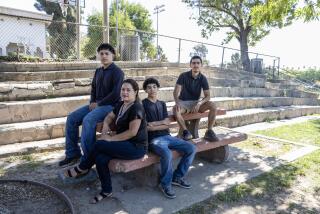A good citizenship quiz
Some immigrant rights activists are afraid that the new citizenship test unveiled by the government two weeks ago will create a new and higher barrier for people who want to become Americans.
They’re wrong. Far from being an exclusionary tool, the new test, which will be given to legal resident aliens who apply for citizenship after Oct. 1, 2008, is actually a rare mechanism for immigrant inclusion, the kind our country needs more of.
It’s true that, historically, whenever the government has introduced a new citizenship exam, it has been responding to shifting national attitudes toward immigration. And the winds today for immigrants -- be they legal or illegal -- are not so friendly. What’s more, this past July, the government raised the citizenship application fee from $400 to $675. That wasn’t exactly a welcome wagon.
Despite expectations to the contrary, the U.S. Citizenship and Immigration Services lived up to its promise to create a new test that would promote democratic values and civic integration -- and wouldn’t be any more difficult than the old one. The new exam does more than simply measure one’s ability to memorize facts. Instead of asking “What country did we fight during the Revolutionary War?” for example, the new exam is more likely to ask, “Why did the colonists fight the British?” It is more about concepts than facts, and it requires newcomers to learn about what it means to be American, not simply how many stripes are on the flag or who wrote “The Star-Spangled Banner.”
A slew of man-on-the-street news stories over the last few weeks revealed that plenty of native-born Americans (who are citizens by accident of birth) wouldn’t be able to answer the new questions off the top of their head. Quick: What are two rights only for United States citizens? (Voting, running for office, carrying a U.S. passport, holding a federal job.) But that’s a meaningless gauge of the test’s difficulty because prospective citizens will be able to study all 100 potential questions and acceptable answers before their oral exam, during which they must answer six out of 10 correctly. So far, of the 6,000 applicants who volunteered to take the new test, 92.4% have passed -- higher than the overall 84% pass rate for the test we’ve been using since 1986.
Too easy, you say? Keep in mind that exclusionary tests were used in other eras to limit immigration and manipulate the ethnic composition of the population. In the early 20th century, for instance, a literacy test was implemented to impede arrivals from southern and eastern Europe. This new exam, however, is concerned with teaching the soon-to-be-naturalized immigrant how to be a good citizen. And that’s a welcome shift in federal policy.
For most of our history, the government has done very little to help immigrants integrate into the mainstream. For all intents and purposes, federal immigration policy largely began and ended at the nation’s borders. A small number of political refugees -- who come here fleeing persecution -- get government resettlement assistance. But most immigrants are left to their own devices. Indeed, foreign wars and international crises have fostered more loyalty to the U.S. among new arrivals than anything the federal government has done.
Some say that rampant globalization and the movement of millions of people across borders have rendered the concept of national citizenship obsolete. Nonsense. They have only made it more important. Citizenship is not just a legal status that confers rights and benefits. Particularly in a highly diverse nation like ours, it is an identity that should give us a sense of a shared fate and belonging. It is also a license to integrate oneself into American civic culture and to participate in a remarkable system of self-government.
For the last two generations, the government and schools have stressed the importance of respecting cultural pluralism. And that’s fine and good. But in this new era of high immigration -- 12% of today’s population is foreign-born, shy of the 15% highs in 1890 and 1910 -- it seems critical for the government to encourage new citizens to identify with our shared political culture.
Centrifugal forces always have seemed strongest in the United States; we push outward, toward new frontiers, far suburbs, away from one another. So it might seem quaint to institute a new civic rite that emphasizes belief in a common culture. But it’s not. The new citizenship test is an important step in the right direction, and a far cry from the coercive assimilationist programs of the early 20th century.
With any luck, it’ll be one of many new efforts that help Americans -- new and old -- balance our healthy regard for cultural pluralism with an equally strong respect for our shared political culture.
grodriguez@latimescolumnists.com
More to Read
Sign up for Essential California
The most important California stories and recommendations in your inbox every morning.
You may occasionally receive promotional content from the Los Angeles Times.










